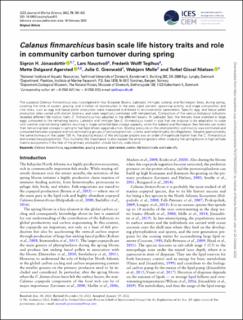| dc.description.abstract | The copepod Calanus finmarchicus was investigated in four Subpolar Basins, Labrador, Irminger, Iceland, and Norwegian Seas, during spring, covering the time of ascent, grazing, and initiation of reproduction in the area. Lipid content, spawning activity, and stage composition and vital rates, such as egg and faecal pellet production were measured and linked to environmental parameters. Specific egg- and faecal pellet production rates varied with diatom biomass and were negatively correlated with temperature. Comparison of the various biological indicators revealed different life history traits C. finmarchicus has adopted in the different basins. In Labrador Sea, the females have invested in large eggs compared to the remaining basins. Labrador and Irminger Sea C. finmarchicus invest in size that we propose to be adaptation to cope with warmer overwintering habitats resulting in larger potential lipid storage capacity, while the Iceland and Norwegian Sea females can invest their remaining lipid storage in spring to fuel lipid-driven egg production. Grazing pressure on the phytoplankton community was estimated and compared between copepod and two dominating groups of protozooplankton; ciliates and heterotrophic dinoflagellates. Despite approximately the same biomass in the upper 100 m, the grazing impact of the protozoan grazers was an order of magnitude higher than the C. finmarchicus dominated mesozooplankton. This illustrates the importance to also include the smallest grazers when studying the spring bloom in high latitude marine ecosystems if the fate of the primary production should be fully understood. | en_US |
